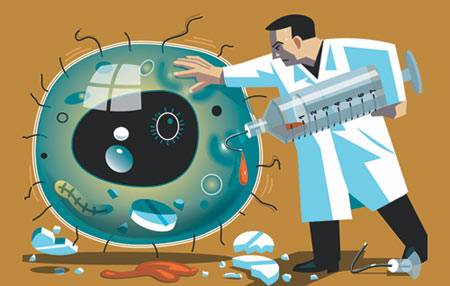
Here’s a realistic image depicting the scene of groundbreaking research leading to the creation of a new antibiotic that evades bacterial resistance. The image showcases a futuristic laboratory with a team of scientists engaged in their work, highlighting the innovation and intense focus on this significant medical breakthrough.
via DALL-E
Scientists at the University of Illinois Chicago and Harvard University have developed an antibiotic that could give medicine a new weapon to fight drug-resistant bacteria and the diseases they cause.
The antibiotic, cresomycin, described in Science, effectively suppresses pathogenic bacteria that have become resistant to many commonly prescribed antimicrobial drugs.
The promising novel antibiotic is the latest finding for a longtime research partnership between the group of Yury Polikanov, associate professor of biological sciences at UIC, and colleagues at Harvard. The UIC scientists provide critical insights into cellular mechanisms and structure that help the researchers at Harvard design and synthesize new drugs.
In developing the new antibiotic, the group focused on how many antibiotics interact with a common cellular target – the ribosome – and how drug-resistant bacteria modify their ribosomes to defend themselves.
More than half of all antibiotics inhibit growth of pathogenic bacteria by interfering with their protein biosynthesis – a complex process catalyzed by the ribosome, which is akin to “a 3D printer that makes all the proteins in a cell,” Polikanov said. Antibiotics bind to bacterial ribosomes and disrupt this protein-manufacturing process, causing bacterial invaders to die.
But many bacterial species evolved simple defenses against this attack. In one defense, they interfere with antibiotic activity by adding a single methyl group of one carbon and three hydrogen atoms to their ribosomes.
Scientists speculated that this defense was simply bacteria physically blocking the site where drugs bind to the ribosome, “like putting a push pin on a chair,” Polikanov said. But the researchers found a more complicated story, as they described in a paper published last month in Nature Chemical Biology.
By using a method called X-ray crystallography to visualize drug-resistant ribosomes with nearly atomic precision, they discovered two defensive tactics. The methyl group, they found, physically blocks the binding site, but it also changes the shape of the ribosome’s inner “guts,” further disrupting antibiotic activity.
Polikanov’s laboratory then used X-ray crystallography to investigate how certain drugs, including one published in Nature by the UIC/Harvard collaboration in 2021, circumvent this common form of bacterial resistance.
“By determining the actual structure of antibiotics interacting with two types of drug-resistant ribosomes, we saw what could not have been predicted by the available structural data or by computer modeling,” Polikanov said. “It’s always better to see it once than hear about it 1,000 times, and our structures were important for designing this promising new antibiotic and understanding how it manages to escape the most common types of resistance.”
Cresomycin, the new antibiotic, is synthetic. It’s preorganized to avoid the methyl-group interference and attach strongly to ribosomes, disrupting their function. This process involves locking the drug into a shape that is pre-optimized to bind to the ribosome, which helps it get around bacterial defenses.
“It simply binds to the ribosomes and acts as if it doesn’t care whether there was this methylation or not,” Polikanov said. “It overcomes several of the most common types of drug resistance easily.”
In animal experiments conducted at Harvard, the drug protected against infections with multidrug-resistant strains of common disease drivers including Staphylococcus aureus, Escherichia coli and Pseudomonas aeruginosa. Based on these promising results, the next step is to assess the effectiveness and safety of cresomycin in humans.
But even at this early stage, the process demonstrates the critical role that structural biology plays in designing the next generation of antibiotics and other life-saving medicines, according to Polikanov.
“Without the structures, we would be blind in terms of how these drugs bind and act upon modified drug-resistant ribosomes,” Polikanov said. “The structures that we determined provided fundamental insight into the molecular mechanisms that allow these drugs to evade the resistance.”
Original Article: UIC research helps create new antibiotic that evades bacterial resistance
More from: University of Illinois at Chicago | Harvard University
The Latest Updates from Bing News
Go deeper with Bing News on:
Cresomycin
- Novel antibiotic 'outsmarts' superbugs, offering new treatment options
Researchers have created a new molecule called cresomycin that works against many bacteria, including some resistant to antibiotics. This is important because these resistant bacteria, often ...
- Could a single synthetic molecule outsmart a variety of drug-resistant bacteria?
The new molecule, dubbed cresomycin, was described Thursday in the journal Science. Cresomycin is not yet a drug, nor is it close to being ready for clinical trials in humans. But it represents a ...
Go deeper with Bing News on:
Synthetic antibiotic
- Researchers systematically investigate efficacy of CRISPR antimicrobial agents
The antimicrobial potential of CRISPR-Cas systems is promising, yet how to best design or implement CRISPR nucleases remains poorly understood. An international team led by the Helmholtz Institute for ...
- The Rise of Natural Polymers: Pioneering Sustainable Material Development
By Taha Khan Apr 25 2024 Reviewed by Lexie Corner Natural polymers are complex molecules composed of long chains of repeating units found in nature. Derived from widely available renewable sources, ...
- Could this pink rice be the food of the future? Scientists say it’s more nutritious than normal rice
A South Korean research team has developed a new hybrid food, an affordable and eco-friendly source of protein, in a bid to develop a sustainable future option.
- Antibiotic Breakthrough: Revolutionary Chinese Study Paves Way for Superbug Defeating Drugs
New research reveals that fluorous lipopetides act as highly effective antibiotics. Bacterial infections resistant to multiple drugs, which no existing antibiotics can treat, represent a significant ...
- Investor stewardship key to fight against PFAS and micropollutants says WHEB AM’s Monteiro
At WHEB, we have been addressing the risk of micropollution through our stewardship and engagement activities for more than a decade. In recent years we have ...










